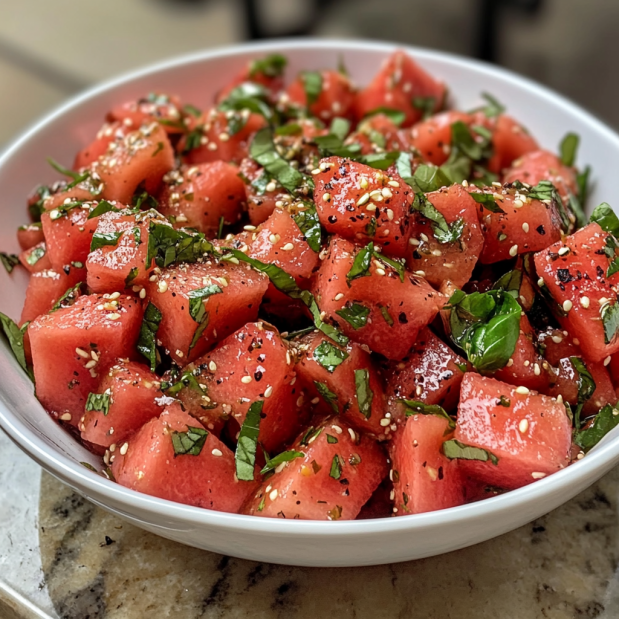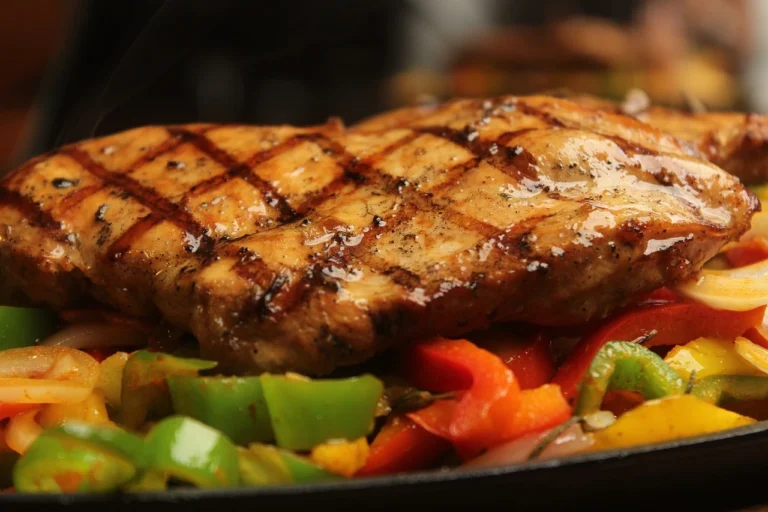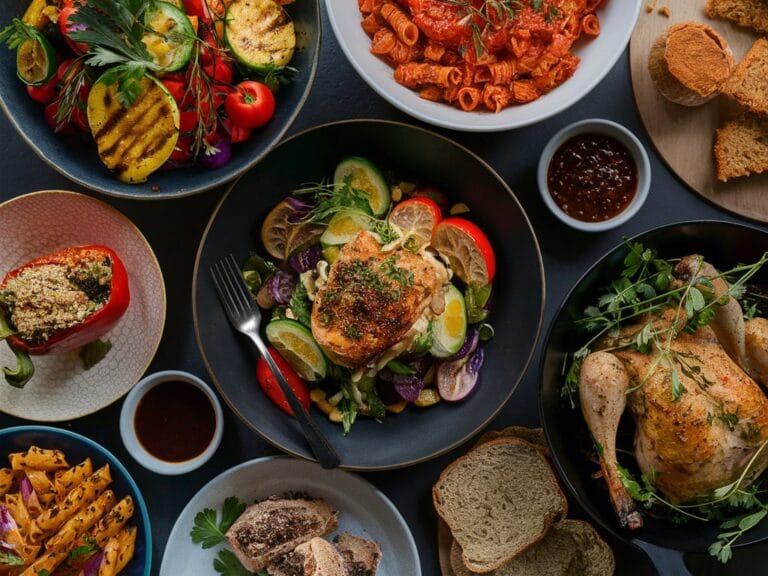Watermelon Basil Salad Recipe: A Perfect Summer Dish
Watermelon basil salad is the epitome of summer. The vibrant combination of juicy, sweet watermelon and fragrant, fresh basil, paired with creamy feta cheese, creates a dish that’s not only visually appealing but also bursting with flavor. This salad is a go-to for summer gatherings, a quick lunch, or a refreshing side dish. In this comprehensive guide, we’ll dive deep into everything you need to know to make the perfect watermelon basil salad, covering ingredients, preparation techniques, variations, and more.
The History and Popularity of Watermelon Basil Salad
Before we dive into the details of how to make the perfect watermelon basil salad, it’s worth exploring the origins and popularity of this refreshing dish. Watermelon has been a staple in summer diets for centuries, dating back to ancient Egypt, where it was cultivated as early as 2000 B.C. The fruit was cherished not only for its sweet taste but also for its high water content, making it a valuable resource in hot climates.
Basil, on the other hand, has roots in ancient India and the Mediterranean. It was often used in religious ceremonies and believed to have healing properties. Over time, basil became a popular culinary herb, especially in Italian and Mediterranean cuisines.
The combination of watermelon and basil might seem unusual at first, but it’s a natural pairing when you consider the balance of flavors. The sweet, juicy watermelon contrasts beautifully with the aromatic, slightly peppery basil. The addition of feta cheese, a staple in Mediterranean cooking, brings a salty creaminess that ties the dish together.
Today, watermelon basil salad is a popular dish in many parts of the world, particularly in regions with hot climates where refreshing foods are in high demand. It’s a dish that not only satisfies the taste buds but also offers a range of nutritional benefits.
Ingredients Overview of Watermelon Basil Salad
Creating the perfect watermelon basil salad starts with choosing the right ingredients. Here’s what you’ll need:
- Ripe seedless watermelon: The star of the dish, make sure it’s chilled for maximum refreshment.
- Fresh basil: Provides a herbaceous note that complements the sweetness of the watermelon.
- Feta cheese: Adds a salty, creamy contrast to the sweet and juicy watermelon.
- Olive oil: Enhances the flavors with its richness.
- Lemon juice: Adds a touch of acidity that brightens the dish.
Selecting the Watermelon Basil Salad
The key to a great watermelon basil salad is starting with a perfectly ripe watermelon. But how do you choose the best one? Here are a few tips:
- Check the field spot: The field spot is the area where the watermelon sat on the ground while growing. A creamy, yellow field spot indicates that the watermelon is ripe. If it’s white or non-existent, the watermelon may not be fully ripe.
- Look for a uniform shape: Whether round or oval, the watermelon should have a consistent shape, indicating even ripening. Avoid watermelons with irregular bumps or flat sides.
- Tap it: Gently tap the watermelon and listen for a deep, hollow sound. This indicates that the fruit is full of water and is likely to be juicy.
- Examine the rind: A dull rind, rather than a shiny one, is another indicator of ripeness. The skin should also be firm and resistant to scratching.
The Importance of Watermelon Basil Salad
Basil is a key ingredient in watermelon basil salad, and its freshness can make or break the dish. Here’s why fresh basil is important:
- Aroma and flavor: Fresh basil has a strong, sweet aroma with a slightly peppery flavor that perfectly complements the sweetness of watermelon.
- Nutritional benefits: Fresh basil is rich in vitamins A, C, and K, and has anti-inflammatory properties. Using fresh leaves ensures you’re getting the most nutrients.
- Visual appeal: Fresh basil leaves add a vibrant green color to the salad, enhancing its visual appeal.
When selecting basil, look for bright green leaves without any dark spots or wilting. If you have a garden, picking basil right before use will give you the freshest flavor.
The Role of Feta Cheese
Feta cheese is another essential component of watermelon basil salad. It adds a salty, tangy flavor that contrasts beautifully with the sweetness of the watermelon. Here’s what you should know about choosing the best feta:
- Type of feta: Feta is typically made from sheep’s milk, but you can also find varieties made from cow’s or goat’s milk. Sheep’s milk feta is creamier and more flavorful, while cow’s milk feta is milder. Choose the type based on your preference.
- Texture: Look for feta that is firm but crumbly. It should hold its shape when crumbled but still mix well into the salad.
- Saltiness: Feta can be quite salty, so taste your cheese before adding it to the salad. You may want to adjust the amount of cheese or skip adding extra salt to the salad.
For a twist on the classic recipe, you could experiment with different cheeses like goat cheese or halloumi, each offering a unique texture and flavor.
How to Prepare the Watermelon Basil Salad
Cutting a watermelon can seem daunting, but with the right technique, it’s a breeze. Here’s a simple step-by-step guide:
- Slice the watermelon in half: Use a large, sharp chef’s knife to cut through the middle of the watermelon, not lengthwise.
- Flip it over: Place the half watermelon flat on the cutting board to stabilize it.
- Slice into wedges: Cut the watermelon into thick slices.
- Remove the rind: Use a paring knife to carefully slice off the rind from each piece.
- Cube the watermelon: Cut the wedges into bite-sized cubes.
If you want to dive deeper into the best techniques, check out this comprehensive guide on how to cut a watermelon efficiently.
Properly cutting and chilling the watermelon is crucial for the texture and flavor of the salad. Cold, crisp watermelon provides the best contrast to the creamy feta and the fragrant basil.
Assembling the Watermelon Basil Salad
Once your watermelon is prepped, it’s time to bring all the ingredients together. Here’s how to do it:
- Combine: In a large bowl, mix the watermelon cubes, crumbled feta, and chopped basil.
- Dress: Drizzle with olive oil and lemon juice. Toss gently to combine.
- Serve immediately: This salad is best enjoyed fresh.
Customizing Your Watermelon Basil Salad
Watermelon basil salad is a versatile dish. You can easily customize it by adding other ingredients like cucumber, mint, or arugula. Here are some variations to consider:
- Cucumber: Adding sliced cucumber to the salad introduces a crisp texture and enhances the refreshing qualities of the dish. This is especially nice in the summer when cucumbers are in season.
- Mint: Mint is a natural companion to watermelon and adds a cooling, herbal note that complements the basil. This combination is particularly popular in Middle Eastern variations of the salad.
- Arugula: For a more substantial salad, consider adding a handful of arugula. The peppery greens balance the sweetness of the watermelon and add more texture to the dish.
If you’re interested in other salads with a refreshing twist, you might enjoy this Mexican cucumber salad.
Adding Other Fruits and Nuts
If you want to take your watermelon basil salad to the next level, consider incorporating other fruits and nuts:
- Berries: Strawberries or blueberries add an extra burst of sweetness and a pop of color to the salad.
- Citrus: Orange or grapefruit segments can add a tangy, zesty flavor that pairs well with the sweetness of the watermelon.
- Nuts: Toasted almonds or walnuts provide a crunchy texture and a rich, nutty flavor that complements the other ingredients.
Experimenting with different combinations can keep the salad interesting and allow you to tailor it to your taste or the occasion.
Nutritional Benefits of Watermelon Basil Salad
This salad is not just delicious but also nutritious. Here’s a quick look at its health benefits:
- Watermelon: Hydrating and low in calories, watermelon is rich in vitamins A and C, which are great for skin health. It’s also a good source of antioxidants like lycopene, which has been linked to heart health and cancer prevention.
- Basil: Known for its anti-inflammatory properties, basil also provides essential nutrients like vitamin K and manganese. Basil’s antioxidants, such as flavonoids, help protect the body from oxidative stress.
- Feta Cheese: While it’s higher in sodium, feta is a good source of protein and calcium, essential for bone health. It also contains beneficial bacteria that can aid in gut health.
Including watermelon basil salad in your meals can be a refreshing way to get your daily intake of fruits and vegetables while staying hydrated during the hot summer months. For another nutritious dish, consider trying this Zucchini Mushroom Recipe that’s both easy and healthy.
Hydration and Weight Management
One of the key benefits of watermelon is its high water content. Watermelon is made up of over 90% water, making it an excellent food for staying hydrated, especially in hot weather. Hydration is crucial for maintaining bodily functions, including regulating body temperature, joint lubrication, and nutrient transport.
Moreover, because watermelon is low in calories but high in volume, it can help with weight management. Eating foods that are low in energy density (calories per gram) can help you feel full while consuming fewer calories, which is beneficial for those looking to manage their weight.
Antioxidant Powerhouse
Both watermelon and basil are rich in antioxidants, which help protect the body from damage caused by free radicals. Free radicals are unstable molecules that can cause oxidative stress, leading to chronic diseases like heart disease and cancer.
- Watermelon: Contains lycopene, a powerful antioxidant that gives the fruit its red color. Lycopene has been studied for its potential to reduce the risk of certain types of cancer, particularly prostate cancer, and its benefits for heart health.
- Basil: Packed with antioxidants such as beta-carotene, lutein, and zeaxanthin, basil helps protect cells from oxidative damage. These antioxidants are particularly important for eye health.
By including watermelon basil salad in your diet, you’re not only enjoying a delicious dish but also giving your body a boost of powerful nutrients.
Serving Suggestions of Watermelon Basil Salad
This salad is incredibly versatile and pairs well with a variety of dishes:
- Grilled meats: The freshness of the salad complements the smokiness of grilled chicken, beef, or lamb. The contrast between the hot, savory meat and the cold, sweet salad creates a balanced and satisfying meal.
- Seafood: Serve it alongside grilled shrimp or salmon for a light and healthy meal. The citrusy notes in the salad can enhance the flavor of the seafood.
- Bread: Enjoy it with a slice of crusty bread to soak up the juices. This simple addition can turn the salad into a more filling dish.
Whether you’re hosting a barbecue or looking for a quick summer lunch, this salad is sure to impress. It’s light, refreshing, and full of flavor, making it an ideal choice for warm weather dining.
Tips for Storing and Making Ahead
While watermelon basil salad is best enjoyed fresh, you can prepare some components ahead of time. Here’s how to ensure your salad stays fresh and delicious:
- Cut the watermelon: Store the cubes in an airtight container in the fridge for up to 2 days. This allows you to prepare the main ingredient in advance without compromising freshness.
- Chop the basil: Only chop the basil just before serving to prevent it from browning. Basil tends to oxidize quickly, which can affect both the appearance and flavor of the salad.
- Assemble right before serving: This helps maintain the salad’s freshness and prevents it from becoming too watery. If you must prepare the salad in advance, keep the watermelon, feta, and basil separate and combine them just before serving.
Storing Leftovers
If you have leftovers, store them in an airtight container in the fridge. However, keep in mind that watermelon tends to release water over time, which can make the salad soggy. For this reason, it’s best to consume the salad within a day or two of making it.
To prevent sogginess, you can also drain off any excess liquid before storing the salad. Another option is to store the components separately and combine them just before eating.
Common Mistakes to Avoid
Even a simple salad like this can go wrong if you’re not careful. Here are some common pitfalls:
- Using overripe watermelon: It can become too mushy and watery, making the salad less appealing. Choose a watermelon that is firm and has a deep color for the best texture.
- Overdressing the salad: Too much olive oil or lemon juice can overpower the delicate flavors. Start with a small amount of dressing and add more if needed.
- Not chilling the watermelon: Serving the salad with room temperature watermelon reduces its refreshing quality. Always chill the watermelon before assembling the salad.
Avoid these mistakes to ensure your watermelon basil salad is perfect every time. With a little attention to detail, you can create a dish that’s not only delicious but also visually stunning.
Popular Variations in Different Cultures
While this version of watermelon basil salad is popular in Western cuisine, variations exist across the globe. Exploring these different cultural interpretations can add a new dimension to your salad repertoire:
- Mediterranean: Often includes olives and a drizzle of balsamic vinegar for an extra tangy flavor. This version might also incorporate other herbs like oregano or parsley, enhancing the salad’s complexity.
- Middle Eastern: Sometimes features sumac for a lemony zing and is often paired with halloumi cheese. The combination of watermelon, mint, and halloumi is particularly popular in Middle Eastern cuisine.
- Asian-inspired: Can include a touch of soy sauce and sesame seeds for a unique twist. This version might also feature ingredients like cucumber, cilantro, and chili for a spicy kick.
Mediterranean Influence
The Mediterranean version of watermelon basil salad often incorporates a wider range of ingredients. For example, adding kalamata olives introduces a briny flavor that contrasts with the sweetness of the watermelon. A drizzle of balsamic reduction adds a tangy, slightly sweet note that enhances the overall flavor profile.
Another common addition in the Mediterranean version is arugula, which adds a peppery bite to the salad. This version is often served as a starter or side dish at summer gatherings, particularly in regions like Greece and Italy.
Middle Eastern Twist
In the Middle East, watermelon salads often feature a mix of sweet and savory ingredients. One popular variation includes the use of halloumi cheese, a firm, salty cheese that’s often grilled before being added to the salad. The grilling process gives the cheese a slightly smoky flavor that pairs beautifully with the fresh watermelon and basil.
Sumac, a tangy spice made from dried and ground sumac berries, is another key ingredient in the Middle Eastern version. It adds a lemony flavor that brightens the salad and complements the sweetness of the watermelon.
Asian-Inspired Variation
The Asian-inspired version of watermelon basil salad often incorporates bold flavors and ingredients. A splash of soy sauce adds a savory umami note, while sesame seeds provide a nutty crunch. This version might also include chili flakes or fresh sliced chili for a bit of heat, as well as cilantro for an herbal freshness.
This variation is particularly popular in Southeast Asia, where watermelon is a common ingredient in both sweet and savory dishes. The combination of sweet watermelon, salty soy sauce, and spicy chili creates a complex and satisfying flavor profile that’s perfect for adventurous eaters.
FAQs
What’s the best type of watermelon for this salad?
Seedless, ripe, and chilled watermelon works best. Ensure it’s not overripe to avoid a mushy texture. The watermelon should be firm to the touch and have a deep red color when cut. A perfectly ripe watermelon will have a sweet aroma and a juicy texture that’s ideal for salads.
Can I use other herbs instead of basil?
Yes, mint is a popular alternative. It adds a different, but equally refreshing flavor to the salad. Mint is especially common in Middle Eastern versions of the salad and pairs well with both watermelon and feta.
How do I prevent the salad from getting watery?
Store the cut watermelon separately and assemble the salad just before serving to avoid excess moisture. If you notice that the salad has become watery, you can drain off the excess liquid before serving. Another tip is to lightly salt the watermelon before adding it to the salad; this can help draw out excess moisture.
Is it possible to make this salad vegan?
Yes, simply omit the feta cheese or use a vegan cheese substitute. There are several plant-based feta alternatives available that mimic the texture and flavor of traditional feta. You can also add nutritional yeast for a cheesy flavor without the dairy.
What can I pair with watermelon basil salad?
It pairs well with grilled meats, seafood, or even as a standalone dish for a light, refreshing meal. For a complete meal, serve the salad alongside grilled chicken or fish, or enjoy it with a crusty baguette and a glass of chilled white wine.
Conclusion
Watermelon basil salad is a delightful and refreshing dish that’s perfect for summer. Whether you’re making it for a barbecue, a quick lunch, or just to enjoy a light and healthy meal, this salad is sure to be a hit. Remember to experiment with different variations and serving suggestions to keep things exciting. Enjoy your summer with this easy and delicious recipe!







